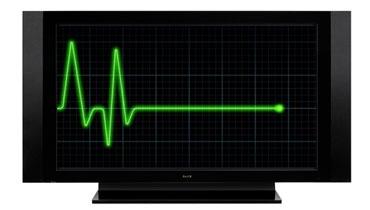Why is Plasma Losing the HDTV War?

Plasma was once the upcoming star of flat screen technology, but it has fallen on hard times. Both Vizio and, sadly, Pioneer announced their exits from the business within weeks of one another, and an ever-growing number of consumers are choosing the more familiar LCD to hang on their walls. Why? Issues with early generations became urban myths, giving plasma some difficult hurdles to clear before a consumer would even lay eyes on it.
Burn-in
Just like CRTs and rear-projection sets before them, early plasmas had a problem with burn-in, but it's a common misconception that it's still a major issue. Better plasma cell technology effectively prevents images from getting permanently burned into a screen with normal use. While modern plasmas do experience image retention when something stays on the screen for hours on end, simply changing the station is usually enough to wash out the ghosting within a few seconds. And some manufacturers have built-in utilities to help get the job done even quicker.
Half-life
In the beginning of plasma's life cycle, many sets could only operate for between 6,000 and 8,000 hours before the display degenerated to half-brightness. The numbers are actually comparable to those put up by the rear-projection CRT TVs competing against the plasmas, but the combination of high price and short life is a scary one. Most current plasmas, however, boast a half-life of about 100,000 hours. If that television is watched six hours a day, 365 days a year, it will take nearly 45 years to get there.
"They don't look as good"
Plasma TVs do not catch the eye like LCDs when placed side-by-side. Often they are not as bright and sometimes, especially on the low-end of things, not that crisp. But PDPs do offer a very natural picture. Unfortunately, that quality doesn't stand out on a retailer's wall. Stores tend to have their demo TV's brightness maxed out which makes LCDs pop. Crank the brightness up that high at home though, and you'll need to pop some Aspirin for the resulting headaches. The brightly-lit fluorescent lights on the showroom floor also don't help plasma's case. They need a home-like setting to truly show what they can do which is why high-end electronics stores with demo rooms tend to stock and sell more plasmas than their big box cousins.
Salesmen need to make a living though, and that means the brightness will stay on high and LCDs will continue to be loaded into buyers' vehicles. If flat screens were demo'd in a home-like setting instead of on a bright showroom floor, things might be different. Many high-end A/V stores stock and sell plasma TVs due to their dedicated demo rooms.
Price
Tattoo artists have a saying: "Good tattoos aren't cheap and cheap tattoos aren't good," which is often true in the case of a plasma panel. When they're good, like Pioneer's now tragically defunct Kuro Elite line, they're incredible. But when they're bad, things can get ugly. Plus, plasmas don't usually get the same kind of slash and burn price cuts that LCDs receive around high volume days like Black Friday and the week preceding the Super Bowl. The models that do get discounted tend to be 720p stuff that's best left for the bargain bin.
Other myths
If all of that wasn't bad enough, there are endless amounts of random rumors that have been passed down in the grand oral tradition of people who have no idea what the heck they're talking about. They range from a need to refill the plasma gas periodically to dangerous materials that seep through the screen. As consumers, we should know that they're false, but they stick around, hurting plasma's bottom line.
R.I.Plasma
When you consider the rate at which manufacturers are dropping plasmas, it seems like these myths may have doomed the amazing technology. Despite their incredible contrast ratios and a wide color gamut, LCDs lead continues to widen. Just like Beta years ago, a superior technology is being brushed aside mostly thanks to bad marketing and misinformation.
- Log in or register to post comments





























































